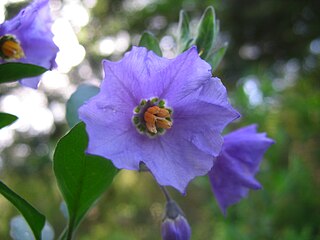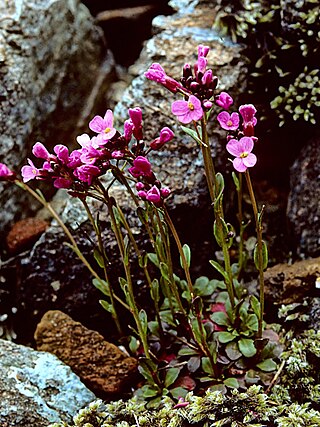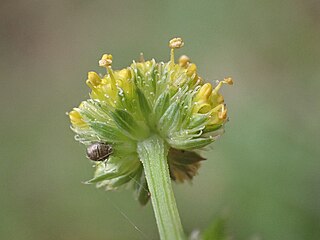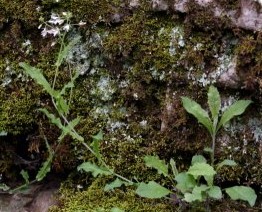
Solanum xanti, known commonly as chaparral nightshade, purple nightshade, and San Diego nightshade, is a member of the genus Solanum. It is native to the Western United States in Arizona, California, Nevada, and Oregon, and to northwest Mexico in Baja California.

Boechera sparsiflora is a species of rockcress known by the common names sicklepod rockcress and elegant rockcress. It is native to western North America from California to Utah to Yukon, where it can be found in a number of habitats. This is a coarsely hairy perennial herb growing one or more thick stems from a caudex. The stem may branch or not and it reaches up to 90 centimeters in maximum height. The leaves vary in shape from linear to arrowhead-like and may or may not have toothed edges. They are usually hairy and up to 8 or 10 centimeters long. The raceme inflorescence bears a number of flowers with spoon-shaped petals about a centimeter long in shades of purple or pink. The fruit is a large, curved silique 6 to 12 centimeters long.
Boechera cobrensis is a species of flowering plant in the mustard family known by the common names Masonic rockcress and sagebrush rockcress. It is native to the western United States from eastern California to Wyoming, where it is found in sandy habitat, especially sagebrush. This is a perennial herb growing several erect, slender stems to heights near half a meter from a branching caudex. The plant forms a narrow clump with a base of narrow, linear, densely hairy leaves up to 5 centimeters long. There are also a few slightly shorter leaves clasping the stems at intervals. The top of each stem is occupied by an inflorescence of small, nodding flowers with dull yellowish sepals and white petals. The flowers give way to fruits which are narrow, straight siliques up to 4 centimeters long containing winged seeds.

Boechera stricta is a species of flowering plant in the mustard family known by the common name Drummond's rockcress. It is native to much of North America, including most of Canada, and the western and northeastern United States.

Arabis lemmonii is a species of flowering plant in the family Brassicaceae known by the common name Lemmon's rockcress. It is native to western North America from Alaska to California to Colorado, where it grows in a number of rocky habitat types.

Arabis macdonaldiana is a species of flowering plant in the mustard family known by the common name MacDonald's rockcress. It is native to northern California and Oregon, where it grows on newly exposed, barren serpentine soils in openings in temperate coniferous forest habitat. It is a rare and endangered plant known from several sites in California and approximately two occurrences in Oregon, where it is threatened mainly by mining, particularly of nickel, which is one of several metals plentiful in the serpentine. On September 29, 1978, this was the second plant to be federally listed as an endangered species.

Boechera breweri is a species of flowering plant in the family Brassicaceae known by the common name Brewer's rockcress.

Sanicula hoffmannii is an uncommon species of flowering plant in the family Apiaceae known by the common names Hoffmann's blacksnakeroot and Hoffmann's sanicle. It is endemic to California, where it is known from the Channel Islands and a few locations in the coastal mountain ranges of the mainland, including the Scott Creek watershed in Santa Cruz County. Its habitat includes coastal hillsides and mountain slopes, sometimes with serpentine soils. It is a perennial herb producing a thick stem up to 90 centimeters tall from a taproot. The green or bluish leaves are compound, the blades each divided into about three lobed, toothed leaflets. The inflorescence is made up of one or more heads of bisexual and male-only flowers with tiny, curving, yellow-green petals.
Packera bernardina is a rare species of flowering plant in the aster family known by the common name San Bernardino ragwort.

Wyethia angustifolia is a species of flowering plant in the family Asteraceae known by the common names California compassplant and narrowleaf mule's ears. It is native to the west coast of the United States from Washington to California, where it grows in grassland, meadows, and other open habitat. It is a perennial herb growing from a tough taproot and caudex unit and producing a stem 30 to 90 centimeters tall. The leaves have lance-shaped blades up to 50 centimeters tall. The inflorescence produces one or more large sunflower-like flower heads at the top of the hairy stem. The head has narrow, hairy phyllaries at the base. It contains up to 21 yellow ray florets each up to 4.5 centimeters long and many yellow disc florets. The fruit is an achene which may be nearly 2 centimeters long including its pappus.
Boechera yorkii is a rare species of flowering plant in the mustard family known by the common name Last Chance rockcress. It is endemic to Inyo County, California, where it is known only from the Last Chance Range in Death Valley National Park. There are only two occurrences known, but the plant occurs in remote, nearly inaccessible mountain territory, so more plants may exist unobserved. The species was only described to science in 2004. Its habitat is rocky mountain canyons on cliffs of dolomite.

Borodinia perstellata, commonly known as Braun's rockcress and Nevada rockcress, is a rare species of flowering plant in the mustard family. It is native to Kentucky and Tennessee, where it is known from perhaps 25 total populations. Most of the occurrences have few individuals, and all are deteriorating in quality. The plant grows in shady forest habitat on limestone substrates, usually near streams or rivers. This is a federally listed endangered species of the United States.

Astragalus desereticus is a rare species of milkvetch known by the common name Deseret milkvetch. It is endemic to Utah County, Utah, where it is known from only one population. It was thought to be extinct until 1981 when this population was discovered. The population contains 5,000 to 10,000 plants on an area of land covering less than 300 acres. It is vulnerable to damage from grazing cattle, which eat the plant and trample the soil, and from development and erosion. This is a federally listed threatened species.
Boechera falcatoria is a rare species of flowering plant in the family Brassicaceae known by the common name Grouse Creek rockcress. It is endemic to Utah in the United States, where it is known only from Box Elder County. It has been reported from neighboring Nevada, but these reports are likely based on misidentifications.
Boechera ophira is a rare species of flowering plant in the mustard family known by the common name Ophir Pass rockcress, or Ophir rockcress. It is endemic to Nevada in the United States, where it is known from Nye and Lander Counties. It grows on the crest of the Toiyabe Range.

Hackelia cronquistii is a species of flowering plant in the borage family known by the common name Cronquist's stickseed.
Astragalus tyghensis is a species of flowering plant in the legume family known by the common name Tygh Valley milkvetch. It is endemic to Oregon in the United States, where it is known only from the Tygh Valley of Wasco County.
Astragalus proximus is a species of flowering plant in the legume family known by the common name Aztec milkvetch. It is native to southern Colorado and northern New Mexico in the United States.
Astragalus wetherillii is a species of flowering plant in the legume family known by the common name Wetherill's milkvetch. It is native to Colorado and Utah in the United States.

Physaria kingii is a species of flowering plant in the family Brassicaceae known by the common name King bladderpod. It is native to western North America from Utah to Baja California, where it grows in dry and rocky habitat, such as deserts and adjacent mountain slopes. This is a perennial herb growing a small, hairy stem from a caudex. The leaves form a patch or rosette around the caudex, each up to 6 centimeters long and round, oval, diamond, or spoonlike in shape. The inflorescence is an erect or mostly upright raceme of bright yellow mustardlike flowers. The fruit is a hairy capsule under a centimeter long suspended on a short, often curvy pedicel.













